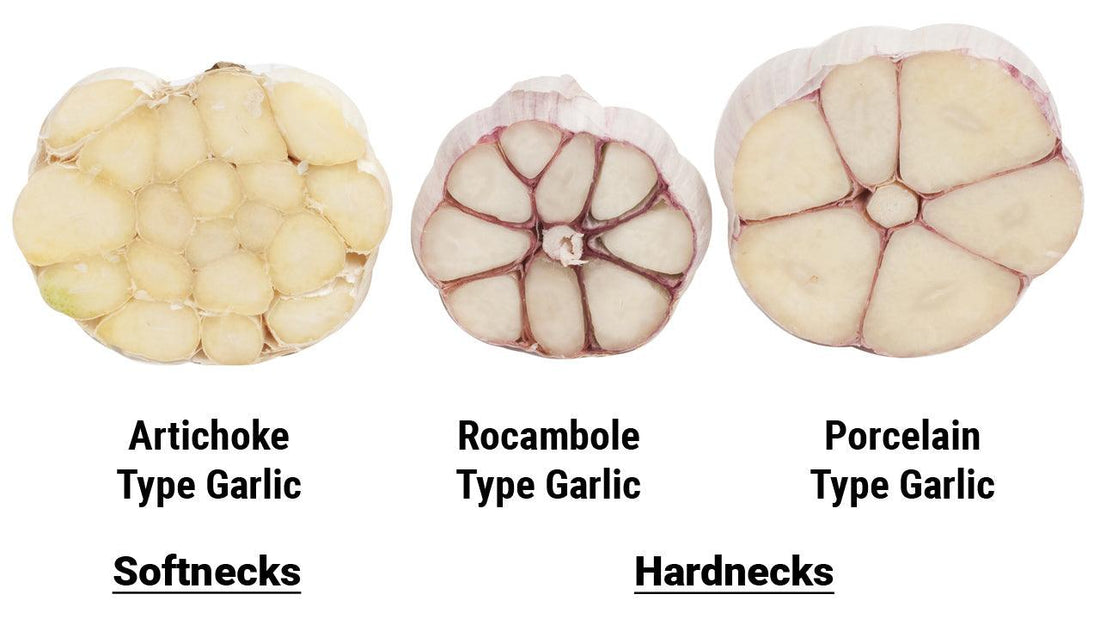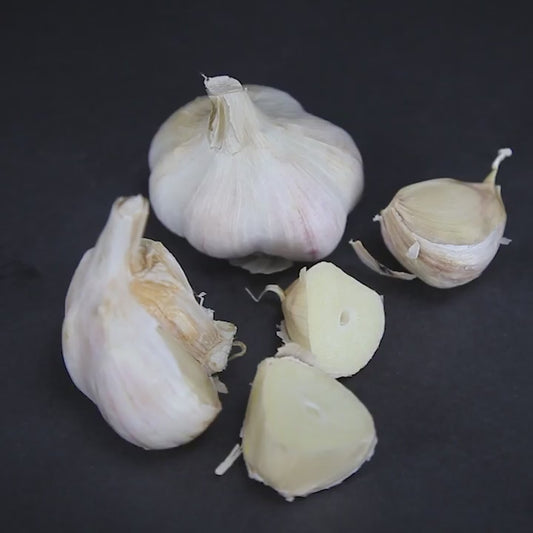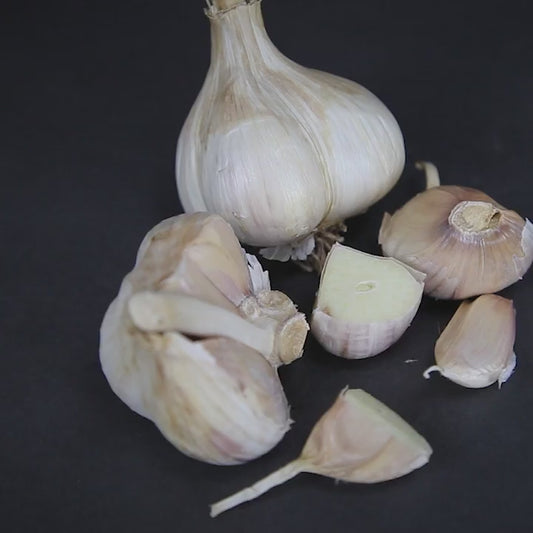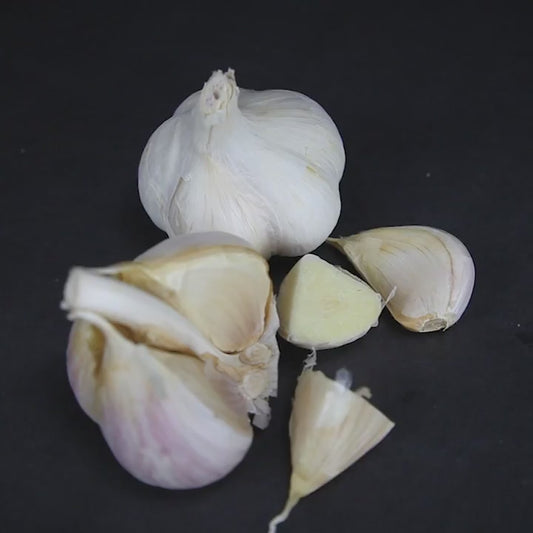Introduction

Creamy aioli, hearty spaghetti aglio e olio, spicy chimichurri ... all around the world garlic is a key ingredient to a delicious meal.
In all corners of the globe, too, garlic farmers have developed their own varieties with unique flavors and colors. Why not grow your own Spanish Roja garlic (perfect for Sopa de Ajo (Spanish Garlic Soup side by side with Siberian garlic and make authentic Russian Piroshki with Vmochanka)? There are two main types of seed garlic to choose from: hardneck and softneck. Elephant garlic, which is actually a member of the leek family, is a separate type.

The Global Appeal of Garlic
Explore the diverse world of garlic with various types and garlic varieties that bring unique flavors to your kitchen. From the rich, bold flavors of hardneck garlic varieties like Georgian Fire and Chesnok Red to the milder taste of softneck garlic varieties, each type offers distinct characteristics.
Whether you prefer the spicy kick of garlic scapes or the convenience of easy-to-peel cloves, there’s a garlic for almost any dish.
With options ranging from porcelain garlic with very large bulbs to the small cloves of artichoke garlic, you can enjoy fresh garlic's complex flavors, long shelf life, and global appeal in your favorite recipes.
Overview of Garlic Varieties
Growing your own garlic opens up a world of flavors and varieties, from the spicy flavor of hardneck garlic to the milder garlic flavor of softneck garlic. Different types of garlic include porcelain garlic, marbled purple stripe, and Creole garlic, each with unique characteristics and uses.
Hardneck garlic varieties, such as German Red and Spanish Roja, produce garlic scapes and are known for their bold garlic flavor, while softneck garlic varieties, like artichoke, have a long shelf life and easy to peel cloves.
Whether you seek the complex flavor of hardneck garlics or the mild taste of softneck types, there's a garlic variety to suit almost any dish, from stir fries to roasted garlic.
Importance of Growing Diverse Garlic Types

Growing a variety of garlic types is essential for maximizing both flavor and adaptability in your garden. Different garlic varieties, including both softneck garlic and hardneck garlic, offer a range of flavors from mild to bold, and come with distinct characteristics such as the spicy garlic scapes of hardneck varieties or the easy-to-peel cloves of softneck varieties.
By planting various garlic types, you ensure a supply of fresh garlic throughout the year, benefiting from their long shelf life and diverse culinary uses, from rich garlic flavor in roasted dishes to the garlicky kick in stir fries. Additionally, this diversity helps cater to different climates, with some garlic varieties thriving in colder conditions and others flourishing in warmer environments.
Understanding Garlic Basics

Garlic, scientifically known as Allium sativum, is a versatile plant celebrated for its distinct and robust flavor. It comes in various types, including softneck garlic and hardneck garlic, each offering unique characteristics such as milder garlic flavor or bold, spicy notes.
Garlic bulbs, which house multiple garlic cloves, can range from large bulbs to medium-sized ones, and are essential in almost any dish, from roasted vegetables to stir fries.
With diverse garlic varieties like Creole garlic and Porcelain garlic, each with its own flavor profile and long storage life, understanding these basics helps in selecting the right type for different culinary uses and climates.
 Historical Significance of Garlic
Historical Significance of Garlic
Garlic has played a vital role throughout history, tracing back to ancient Egypt where it was revered for both its medicinal and culinary properties. Various types of garlic, including softneck garlic and hardneck garlic, have been cultivated over centuries, each with unique characteristics such as bold garlic flavor or milder taste.
Historical records highlight the use of garlic cloves in traditional remedies and cuisine, showcasing its rich garlic flavor and versatile applications in dishes like roasted vegetables and stir fries.
From ancient civilizations to modern times, garlic varieties like Creole garlic and Spanish Roja continue to be celebrated for their complex flavors and long shelf life, reflecting garlic's enduring importance in diverse cultures.
Garlic Varieties by Region

Asian Garlic Varieties
Asian garlic varieties offer a diverse range of flavors and characteristics, each suited to different culinary uses. Chinese Pink Garlic is known for its mild taste and easy-to-peel cloves, making it a popular choice in many stir fries and recipes where a subtler garlic flavor is desired.
Korean Red Garlic provides a bold and spicy flavor, ideal for adding a rich kick to dishes, while Japanese Aomori Garlic stands out with its complex flavor and very large bulbs, often used in traditional Japanese cuisine for its robust and aromatic qualities.
These types of garlic highlight the unique garlic varieties cultivated across Asia, each contributing distinct flavors and textures to global culinary traditions.

European Garlic Varieties
European garlic varieties offer distinctive flavors and qualities that enhance a range of culinary dishes. Spanish Roja is a popular hardneck garlic with bold garlic flavor and a rich taste, known for its large cloves and long shelf life.
Italian Purple Garlic features a complex flavor and attractive purple stripes, producing medium-sized bulbs with a garlicky kick that shines in Italian recipes. French Creole Garlic, with its mild taste and easy-to-peel cloves, adds a subtle richness to dishes, making it a favorite among those who prefer a softer garlic flavor.
These garlic types highlight the diverse garlic varieties found across Europe, each bringing unique characteristics to the kitchen.

North American Garlic Varieties
In North America, distinct garlic varieties offer unique flavors and growing benefits. California Softneck garlic, a popular softneck garlic, is known for its mild taste and long storage life, making it a staple in many kitchens.
Oregon Blue garlic stands out with its bold garlic flavor and large bulbs, prized for its spicy notes and suitability for roasting. Music Garlic, a hardneck garlic variety, delivers a rich, complex flavor with large cloves and a robust, garlicky kick, ideal for those who enjoy a bold garlic flavor in their dishes.
Each of these North American garlic types contributes to the diverse garlic varieties available, each suited to different culinary and growing needs.
Softneck Garlic
-
Softneck seed garlic, also called artichoke garlic due to their numerous cloves that give them an appearance similar to the “petals” of an artichoke head, is the most common garlic due to its excellent storage characteristics. This is the kind you will find in grocery stores.
-
Softnecks are the most heat tolerant of garlic, and have a sweeter, milder flavor than hardnecks. If you’re looking to make garlic braids, this is the type to grow.
-
They come in both white and red varieties.
-
Varieties include California Late White, California Early White, Inchelium Red, Early Purple Italian, Sonoran and Sicilian.

Hardneck Garlic
Hardneck seed garlic grows with a hard center stalk around which the cloves grow. This type of seed garlic is more assertively flavored, easier to peel, and has bigger (though fewer) cloves than softneck. They grow best in areas with freezing winter temperatures. Their vibrant colors and superb flavor make these gourmet garlics an excellent choice for the garden, especially as their short storage time means that you are unlikely to find them from your local grocer.
Hardnecks are classified in three categories: rocambole, porcelain, and purple stripe. These categories have been refined based on recent garlic DNA testing, which also showed that originally all garlic came from the Caucasus Mountains before selective breeding created new regional varieties. These categories also provide easy guidelines for selecting the best hardneck seed garlic for your gardening and culinary needs.

Rocambole
Rocambole seed garlic has wrappers that are typically reddish in color, such as Georgian Red, Russian Red, or Spanish Roja. However, color is not the only requirement for this category, as some varieties may be white or purple colored.
Rocambole scapes are more tightly curled than other varieties. Most rocambole varieties produce 8 to 10 cloves per head.
Purple Stripe
Purple stripe seed garlic has wrappers that are typically purple, although some varieties can have white or red coloration. These include Bogatyr, Metechi, Purple Glazer, and Siberian. Purple stripe seed garlic typically produces 5 to 10 cloves per head, depending on variety.
Purple stripes can be further divided into “standard purple stripe” which have vibrant purple striping on their wrappers, “glazed purple stripe” which have a deep purple wrapper tingled with gold or silver hues, and “marbled purple stripe” which are more likely to be mottled than striped and may resemble rocambole.

Porcelain
Porcelain seed garlic has wrappers that are predominately white, sometimes with a blush of red or purple, and include Georgian Fire, Music, German, Norquay, and German Xtra Hardy. Porcelain’s lovely color and excellent flavor makes these among the more popular varieties of hardneck seed garlic.
Porcelains tend to have less cloves per head, at 4 to 9 depending on the variety; however the cloves can grow to be quite large compared to other seed garlic varieties.

Culinary Uses of Different Garlic Varieties
Fresh Garlic vs. Aged Garlic
When exploring garlic in the kitchen, the types of garlic you use can dramatically influence the outcome of your dishes. Fresh garlic, whether it's softneck garlic or hardneck garlic, offers a vibrant, bold garlic flavor that can elevate stir-fries, roasted vegetables, and sauces with its pungent bite and complex taste.
In contrast, aged garlic, such as that used to make garlic powder, develops a mellower, sweeter flavor profile and can be a subtle addition to dishes where a milder garlic flavor is desired.
Each garlic variety, including hardneck garlic varieties like German Red or Creole garlic, provides unique taste characteristics and applications, from the rich, garlicky flavor of fresh cloves to the nuanced depth of aged garlic.

Garlic in Cooking
In cooking, different types of garlic offer distinct flavors and uses. Raw garlic cloves, whether from softneck garlic or hardneck garlic varieties, deliver a bold, spicy flavor that can invigorate any dish. For a milder and more nuanced taste, roasted garlic transforms the garlic flavor into a sweet, rich essence perfect for spreading on bread or adding to sauces.
Meanwhile, garlic powder and granules provide a convenient way to incorporate garlic flavor with a long shelf life, making them ideal for seasoning dishes like stir-fries or in recipes that call for a more subtle, uniform garlic taste.
Each form—fresh garlic, roasted, or dried garlic powder—adds a unique dimension to your cooking, reflecting the versatility of garlic across garlic varieties.
Pairing Garlic with Different Cuisines

When pairing garlic with different cuisines, the garlicky flavor of each garlic variety can significantly impact the dish. For Mediterranean dishes, softneck garlic or hardneck varieties like Chesnok Red, with their delicious and rich flavor, enhance everything from olive oil drizzles to pasta sauces.
In Asian dishes, the intense and spicy flavor of hardneck garlic varieties with many cloves complements stir-fries and noodle dishes. For American dishes, regular garlic bulbs with their papery skin and soft neck are ideal for roasting or grilling, providing a robust taste that pairs well with meats and vegetables.
Whether you choose hardneck garlics from colder climates or softneck varieties from warmer climates, each garlic type offers a unique flavor profile that can elevate your cooking.
Conclusion

Garlic's global appeal is a testament to its versatility and essential role in cooking. From the garlicky flavor of Spanish Roja in Spanish dishes to the bold, spicy notes of Korean Red Garlic in Korean cuisine, each garlic variety brings unique characteristics that enhance various recipes. Softneck garlic offers a milder taste ideal for braiding and long storage, while hardneck varieties like German Red and Chesnok Red deliver rich, complex flavors suited for robust dishes.
Whether you're growing garlic in your garden or exploring different types in the kitchen, the diverse range of garlic bulbs and cloves ensures there's a perfect fit for every culinary need. From fresh garlic to garlic powder, the adaptability of garlic enriches dishes worldwide, making it a staple ingredient in many kitchens. Embrace the world of garlic flavors and discover how each variety can transform your cooking experience.
Select several varieties of seed garlic to grow in your garden and enjoy a world of garlic flavors! Visit our seed garlic collection for a variety of garlic seeds for sale. For an all-in-one experience, consider our Garlic Combo Pack, which includes Elephant Garlic, California Late White, Music Garlic, Russian Red Garlic, California Early White, Chesnok Red, Inchelium Red, and Metechi.







